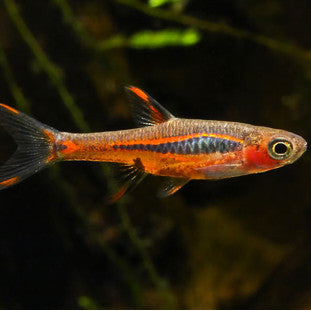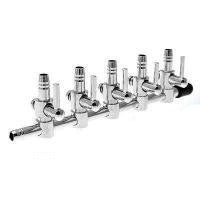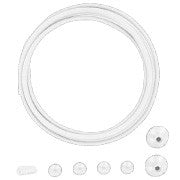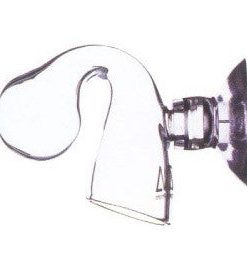Mosquito Rasbora (Boraras Brigittae) FNM
$ 2,00 $ 1,20
Native to Southeast Asia, the Mosquito Rasbora (Boraras brigittae) thrives in the tropical forest swamps and waterways. In their natural habitat of black water streams and pools, tinted dark brown from decaying organic matter, they seek shelter among the dense vegetation made up of leaves, branches, and twigs. These small fish species use this intricate maze as hiding spots and a prime hunting ground for small crustaceans, insects, worms, and zooplankton. With their adaptability to the dimly lit and highly vegetated environment, they will thrive in a well-designed aquarium with soft, acidic water.
Although the Mosquito Rasbora is small in size, it is not suitable for very small 3 to 5 gallon pico aquariums. This is because they require stable water parameters and ample swimming space. In the wild, these fish live in streams with a large volume of water, which helps maintain stable water conditions. Additionally, they are accustomed to having plenty of room to swim through vegetation, so they will appreciate a spacious aquarium in their home. A minimum of a 12 gallon nano-cube or 20 gallon standard aquarium is recommended for this species. Due to their small size and shy nature, the Mosquito Rasbora is only suitable for peaceful community aquariums, without any semi-aggressive species such as Angelfish, Catfish, or Barbs. They can thrive in a biotope setup, a species-only tank, or when housed with other small and peaceful fish. These fish are also shoaling species, so it is best to keep them in groups of
An ideal housing setup for Mosquito Rasboras should include a sandy substrate, abundant vegetation, and shaded or dimly lit areas. The aquarium should be planted with ground cover plants and driftwood, providing hiding spots and a comfortable habitat for the fish. Floating and surface-covering plants are recommended for their ability to filter strong lighting and create dimmer areas in the tank. To replicate the natural tint and acidity of the water, dried leaves, peat, or black water extract can be added to the aquarium. Decaying leaves on the bottom of the tank also serve as a supplemental food source for the fish by providing nourishment for micro-organisms.
As an expert in the field, it is important to note that the Mosquito Rasbora primarily feeds on micro-foods such as small insects, crustaceans, worms, and zooplankton in the wild. Due to the difficulty of reproducing these foods in a home aquarium, a variety of commercially available options can be used as substitutes. These include frozen and freeze-dried worms and daphnia, as well as crushed flake foods. For optimal nutrition, it is recommended to feed the Mosquito Rasbora a diverse menu of flake, freeze-dried, and frozen meaty foods that are small enough for them to consume. This can include crushed high-quality flake foods, tubifex worms, cyclop-eeze, and baby brine shrimp, to be consumed twice a day in small portions that can be finished within a 3 to 5 minute timeframe.
Purchase Size: approx 1″
* For online orders of livestock, please allow a slightly longer delivery time to account for handling during shipment and quarantine processes. This may range from 1-3 weeks, but it will ensure the health and well-being of your new addition.
* All Livestock is for Sale in Singapore only and and Not Available for overseas export.
Fast Shipping and Professional Packaging
We can offer a variety of shipping options thanks to our long-term relationship with UPS FedEx DHL. Our warehouse staff will package all goods to our exacting requirements. Prior to shipping, your goods will be thoroughly examined and securely secured. We deliver to thousands of customers every day from all over the world. This is a sign of our determination to be the largest online retailer in the world. Warehouses and distribution centers are located throughout Europe as well as in the USA.
Note: Orders that contain more than one item will be assigned a separate processing time for each item.
Prior to shipment, we examine the items ordered thoroughly before sending the items. Most orders are shipped within 48 hours. The expected delivery time is 3 to 7 days.
Returns
The stock is constantly changing and cannot be fully controlled by us due to the involvement of many different parties, such as the factory and our warehouse. The levels of stock can change at any moment. You may not receive your order once the order has been made.
The policy is 30 days. If it's been longer than 30 days since you made your purchase and we're unable to offer you a complete exchange or refund.
To be eligible for a return your item must be unused and in the same condition as you received it. You must have the item in its original packaging.
Related products
Conditioner
Substrate
Air Pump Accessories
Freshwater Plant
Bacteria
Air Pump Accessories
Bacteria
Filter Media
Air Pump Accessories
Air Pump Accessories
Plant Fertilisation
Plant Fertilisation
Freshwater Plant
Substrate
CO2 Accessories
Maintenance Tools
Plant Fertilisation
CO2 Accessories
Uncategorized





































